Norway was the country that fascinated me the most with its natural beauty among the countries I visited during my 40-day trip with Interrail. Since I had been in July, I witnessed the white nights. I also hope to return in winter to see the northern lights. I had seen many photos and movies about the natural beauty of Norway. I witnessed people who had been there say, but it is an entirely different thing to see it with one’s own eyes. Because neither a photograph nor a movie frame can do justice to this beauty. You have to see it with your own eyes and inhale that air.
Traveling by train and bus in Norway is a pleasure; the scenic views along the way add to the experience of reaching your destination.
We took the train from Gothenburg, Sweden, and enjoyed the beautiful scenery on our way to Oslo. A delightful surprise awaited us upon our arrival. Mr. Mustafa, a friend I had met years ago while working for Turkish Airlines in Miami, welcomed us in Oslo and made our trip incredibly comfortable and enjoyable. There is nothing quite like exploring a city with locals who can provide insights that you won’t find online. Mustafa and Mr. Halil, who drove us around throughout the day, exemplified Turkish hospitality. Since we had to catch a train to Bergen in the evening, they helped us make the most of our limited time, guiding us to all the key sights we wanted to see.
First, we drove up Ekeberg Hill and parked at an area called Ekebergsletta, where we enjoyed a view of Oslo from the top. While there, we received information about the city. Next, we had venison and mashed potatoes at the famous Frognerseteren Restaurant. In front of the restaurant, there were trees where small red berries known as Biringeber are harvested. We also tried a fruit juice made from the Raharber brand bringeber. After our meal, we got back in the car and headed to the nearby ski slope that hosted the Oslo Winter Olympics and world ski competitions. We took photos in front of it. We also saw Ullevaal Stadion, the football stadium of Oslo.
Once there, Mrs. Suheyla, Mr. Mustafa’s wife, joined us, and together we all went to Frogner Park, a must-see attraction for anyone visiting Oslo.
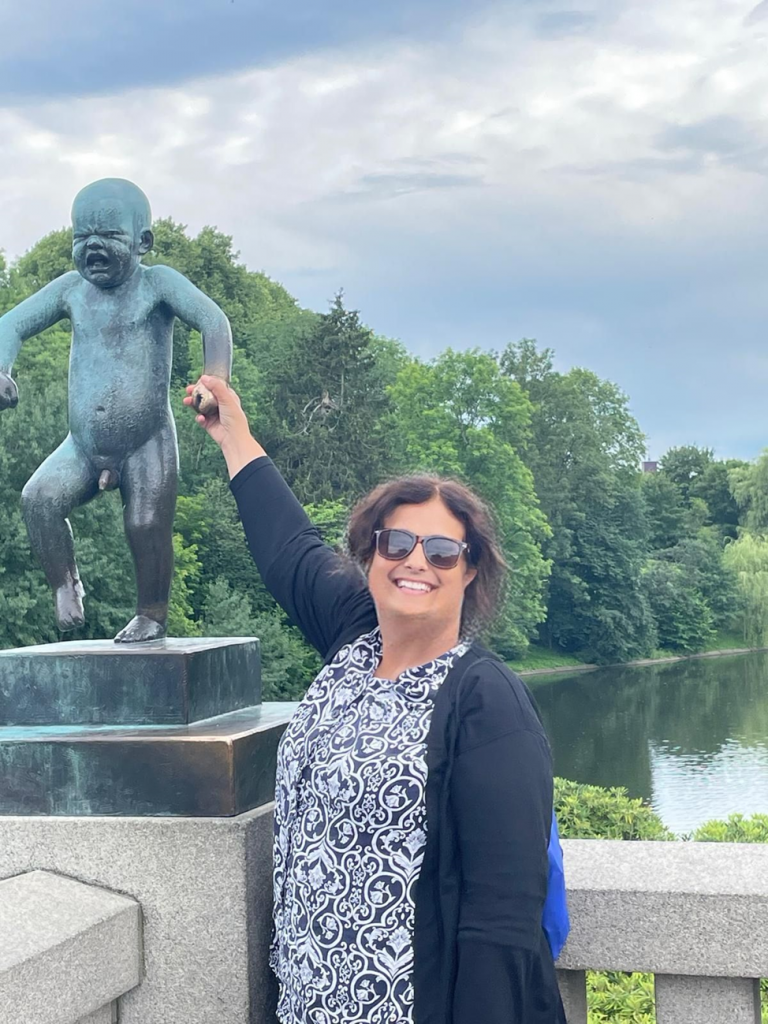
We visited the park where the famous sculptor Gustav Vigeland’s sculptures of naked women, children, and men are displayed. I took a photo with the statue of the angry child, known as Sinnataggen, which is Vigeland’s most famous sculpture. He also designed the Nobel Peace Medal. Over time, the color of the statue’s hand has changed because many visitors pose while holding it. Vigeland’s collection includes 212 granite and bronze sculptures, all exhibited in Frogner Park, which is the largest open-air sculpture museum in the world, spanning 320,000 square meters. We were quite impressed to learn that it took about 20 years to create all the sculptures. Vigeland created a massive column adorned with 121 nude human figures. We took a moment to relax beneath this 17-meter column, known as the Monolith, where we watched people dancing the tango to music. Afterward, we returned to the car and drove through Majorstuen, one of the oldest settlements in Oslo. We then went to Sofienberg, where we sat in Mr. Mustafa’s café and enjoyed tea. While there, we chatted with a woman who had once been a member of the Norwegian parliament.
Next, we drove to Sentrum. Upon arriving, we got out of the car and walked into Steen & Strøm, where we found paintings and an open-air exhibition in front of the famous parliament building. After a long and pleasant walk, we reached the Norwegian Royal Palace, passing by the National Theater and strolling along a beautiful boulevard lined with trees.
We were surprised to see giant rats on the streets. There were also protesters in front of the parliament building. After the Norwegian parliament, we drove past the painters and arrived at Oslo train station by car. We found the train platform and took the train to Bergen.
We spent the night trying to sleep on the train. When I woke up in the morning, I saw that we were passing through lakes and mountains. It looked even more wonderful with the colors of the sunrise.
We arrived in Bergen very early in the morning. Since we were staying at home and not in a hotel, we left our belongings in the storage room. Our Interrail ticket was not valid on the Flam line, so we bought a new ticket. We had to go to Mrydal station to get on the nostalgic train. We could use our Interrail passes on that train. Although it was July, the weather was quite cool and we were wearing our winter coats. The nostalgic train from Mrydal was going to Flam, Flamsbana was built between 1923 and 1940, and has been voted the most beautiful train line in the world many times. Some of the 20 tunnels were carved by human hands. We stopped at the Kjosfossen Waterfall. We got off the train and saw a girl dancing behind the waterfall to beautiful music. I was mesmerized by the beauty of nature and felt tears in my eyes. During this journey, which lasted about 1 hour, we passed through steep and sharp slopes and 20 tunnels. we saw lush green hills, white sparkling waterfalls. The Flamsbana train lands in the town of Flam, located on the slopes of Aurlandsfjord, one of the tributaries of the Sognefjord, Norway’s largest fjord. You can see the views better if you sit on the left side of the train. After visiting the train museum in Flam, we bought the Fjord tour for 485 kroner from the website. When we got on the boat, we preferred to sit on the upper side and enjoy the wonderful view that God gave to Norway.
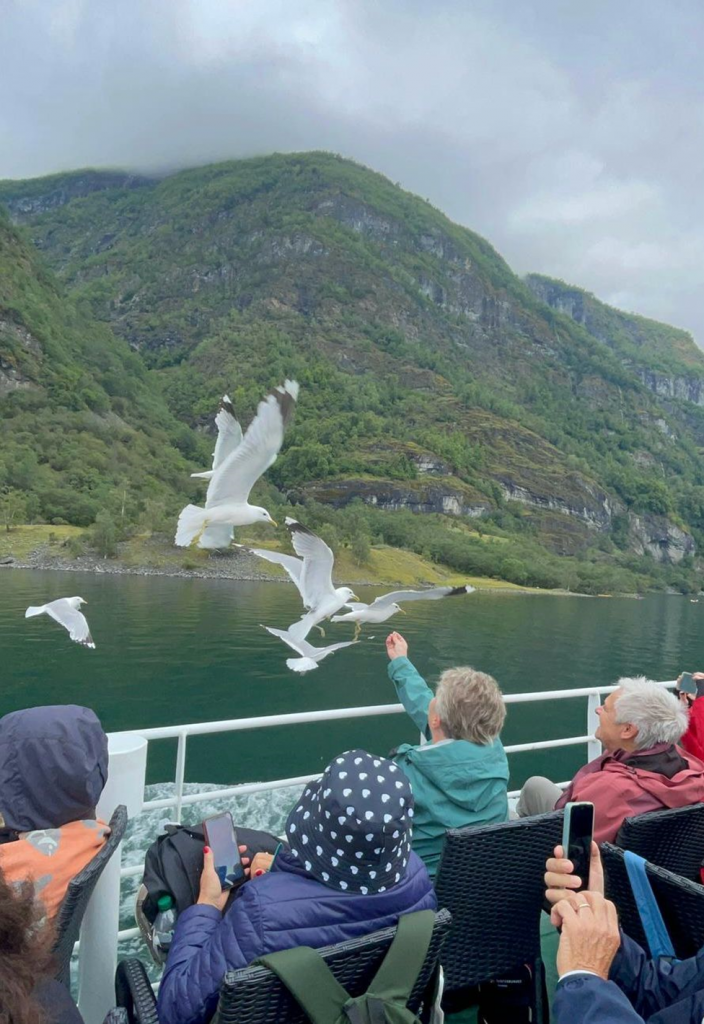
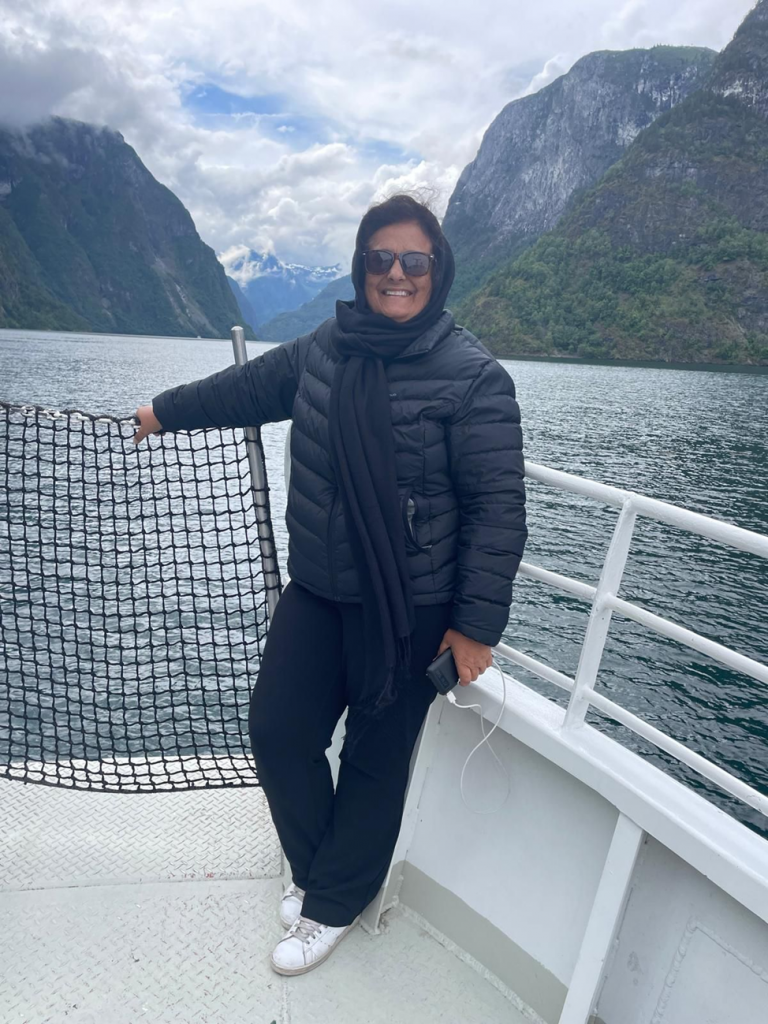
Seagulls accompanied us along the way. The number of seagulls increased as other passengers imitated us feeding them with our hands, and a spectacular sight was created. Lush green hills with steep slopes, waterfalls, seagulls, in short, it was a visual feast.
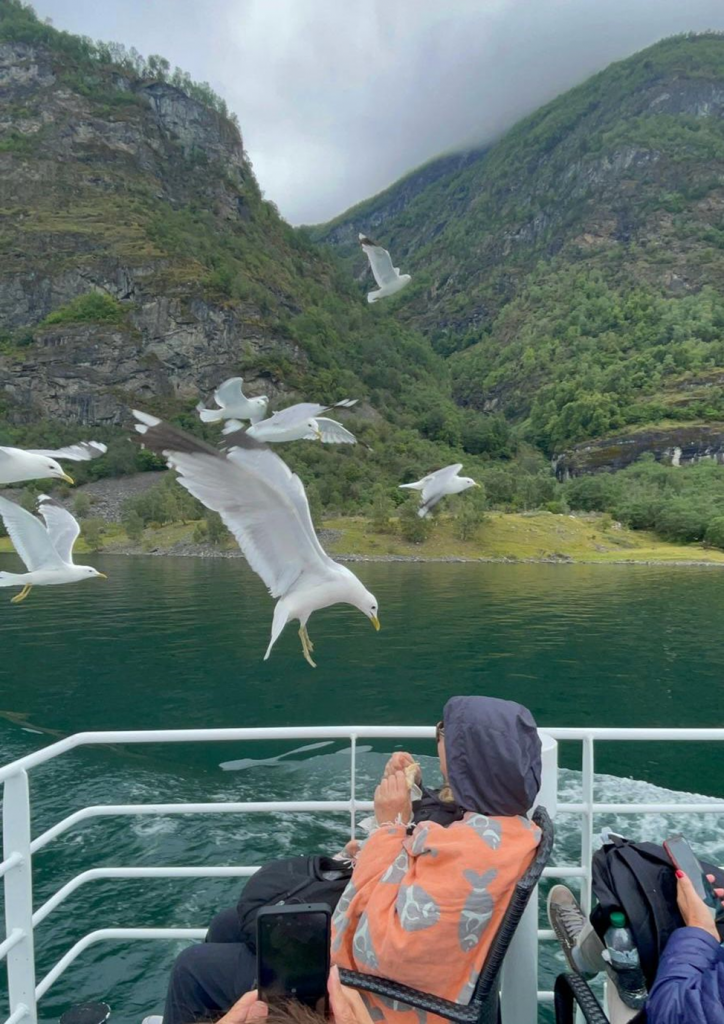
Instead of returning by boat through the same canal and taking the train from Flam, we preferred to get off in Gudvangen and return by bus, which would be both faster and more economical, but the bus did not pass through the town but up the road, so after walking up the hill and waiting at the bus stop for a long time, we arrived in Voss with a wonderful view. From there, we took the train to Bergen. We picked up our belongings from the train station and reached the house we rented. It was quite tiring to go to the top floor of the apartment without an elevator.
The next morning, we woke up early and wandered the empty streets of Bergen city before breakfast. It was like a fairy tale city with its narrow streets, colorful wooden houses, and flowers in front of them. Founded in 1070 and becoming the capital of Norway in the 12th and 13th centuries, this city is very developed in the field of culture and education, and there are many scientists who have received Nobel prizes from the University of Bergen.
There were small tourist buses in the city, but we preferred to walk everywhere because the sights were very close to each other. If you go to Bergen, I recommend wearing comfortable shoes. As in most of the Scandinavian countries, the streets of this city are paved with cobblestones, which makes it difficult to walk. We also visited the inside of Bergen Cathedral, which looked magnificent from the outside. There were souvenir sellers, restaurants, and open fish markets in the Port of Bergen area. We were very interested in the sausages made from whale and deer that we tasted there.

Of course, when you come to this region, you need to see the Bryggen houses. Built in the 14th century and rebuilt after the great fire in 1702, and protected by UNESCO, these beautiful, colorful wooden houses are home to souvenir sellers and restaurants. After visiting the fish and flower market, we took a small boat ride in the harbor. I took the funicular to Floyen (Floibanen) hill and looked at the city of Bergen, which consists of 7 hills, from a height of 320 meters. You can return either by funicular or on foot. Since it was summer, the sun was setting at 11 at night. People were sitting on the viewing terraces and in the cafes on the hill, both looking at the panoramic view and waiting for the sun to set. The next day, we left the house where we were staying and went to the bus station, this time because there was no train between Bergen and Stavanger; the only option was the bus, and I had one of the most interesting bus journeys of my life. We saw amazing landscapes along the way. We took the ferry twice and traveled through many tunnels. It was a long journey. It took 4.5 hours to go by the coastal bus called Kystbusten. I can also say that it was the most expensive bus I have ever taken in my life because it cost around 79 Euros. In Stavanger, we stayed in a house close to the beach. This time, the house was not completely ours; there was another family because the room was rented. We did grocery shopping and ate the food we cooked ourselves in the kitchen on the second floor. Our room was on the third floor.
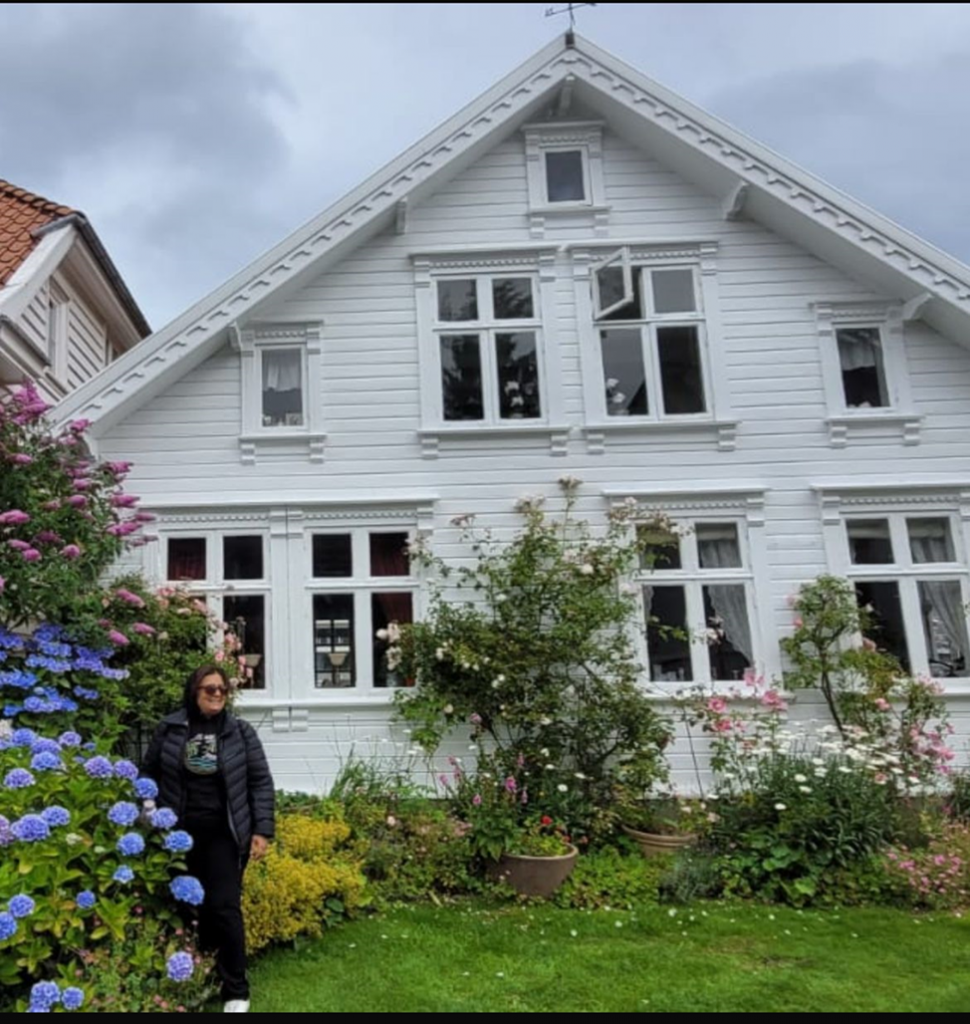
The next morning, we wandered around the streets of Stavanger and saw beautiful, colorful wooden houses and flowers. The shopping streets in the city center were also home to cute shops and restaurants. We found a restaurant called Döner in the bazaar and got information about the city from the young Turkish man working there.
Luckily, there was a festival in the city. In the evening, we watched bands singing on a big stage set up by the sea. The city was beautiful with its night lights.
The next morning after breakfast, we went to the harbor and bought a Fjord cruise ticket from one of the huts set up there. We paid 795 kroner (79$). This time, the Fjord cruise was going to Lysefjord and Preikestolen. The trip took 3 hours, we saw wonderful fjords, and it was very cool again. Still, we preferred to go above. We saw the Pulpit cliffs from below.
Reaching the top of the cliff required a challenging trek. However, after reading numerous comments warning that “you should wear good shoes, or you might end up shoeless on the return trip,” we decided to admire the view from below instead. This cliff, known as Preikestolen in Norwegian, is where the climbing and fight scenes in the movie “Mission: Impossible” featuring Tom Cruise were filmed.
We continued on the 42 km long Lysefjord. We stopped at Vagabond Cave, where the ship’s guide told us about the legend that vagabonds who escaped from the police hid here. When we went to the Whisky Falls, we saw tourists with inflatable boats and life jackets trying to fill their glasses and drinking water. A boy aged 11-12 followed us on a speedboat and performed various acrobatic shows, and goats roaming the steep slopes added color to this visual feast. After returning to the port, we visited the Eiganes district and saw beautiful houses decorated with flowers and narrow streets.
The most interesting place we visited during the trip was the Eiganes cemetery. In a corner of the park in a beautiful neighborhood where the rich lived, the cemetery was home to 25 soldiers who were martyred in World War II. At night, we watched the festival artists’ dance and music shows on the port side for free. The next day, we took the train to Egersund and toured this cute town. We had a delicious seafood lunch at a floating restaurant.
It was time to leave Stavanger. We took the train at night and set off for Oslo. In Konsberg, they transferred us to a bus because there was maintenance work on the railway. Fortunately, Mr. Halil came to pick us up from the Oslo train station. First, we went to Mustafa Bey’s cafe bar, where they prepared breakfast for us. Then they dropped us off at the Oslo city center again by car. Here we visited the museum where 1200 paintings and other works of art by the world-famous Norwegian painter Edvard Munch are exhibited. The museum, which was founded in 1963, moved to the building we visited in 2021. We waited with the crowd to see the original of the famous Scream painting. It slowly came out of the darkness into the light, and people were recording this moment with their mobile phones; the paintings were changing with another version every half hour. Munch made two oil and two pastel versions of the Scream painting between 1893 and 1910, as well as a series of prints. His other famous paintings, such as Madonna, the Sick Child, and Adolescence, were also there. After the museum, we visited the Sentrum area and mingled with the tourists walking by the sea. We also saw floating saunas here. It was possible to sail out to sea with these boat-type saunas and cool off by swimming in the sea after the sauna. The famous Oslo Opera House, where Norwegian opera and ballet performances are performed, caught our attention with its interesting architecture. Then we went to Salt. This is a place that attracts both Norwegians and tourists with its saunas, restaurants, cafes, and venues where various cultural activities and concerts take place every day. It was time to leave Norway. In the evening, we went to the train station and got on the Swedish train to Stockholm. We left Norway with beautiful memories.
Norway’s economy is robust, thanks to its strong maritime, fishing, and oil industries. They are also advanced in technology. Norway is worth seeing and living in due to its high quality of life, free education, extensive healthcare services, natural beauty, and the possibility of doing outdoor sports. Although it is an expensive country, the purchasing power of the people is high. The country has a very good level of education and naturally has a low crime rate. The rich Viking history, music concerts, and festivals also attract tourists here. The country’s government is a constitutional monarchy. It is governed by a parliament and a prime minister. Harald V, who has been the king of Norway since 1991, is married to Sonja Haraldsen, a commoner. Norway, with a population of 5.5 million, hosts 931,000 immigrants. Financial aid is provided to those who come as refugees. Norway, which has been voted the most democratic country many times, has long had fair and competitive elections governed by an independent electoral board. In Norway, where ideas are discussed instead of forming an unconditional consensus or imposing an opinion, it is possible to see that the best thing is not to be alone but to be many, and that discussion does not mean fighting and does not turn into a fight. In Norway, those who come to power can stay in power as long as they respect the rights of those who do not come to power. Norway, ranked first in press freedom in 2024, is truly a cradle of democracy.
There is even a sentence that we use when discussing democratic rights that has become part of our language: “Is this Norway?”
Norway is frequently recognized in various studies as the country with the happiest people in the world. It boasts a high level of peace and prosperity and is renowned for its midnight sun and northern lights. This makes it one of the top destinations worth visiting.
I hope you add Norway to your bucket list.
Your traveler friend, Canan…
Canan Sezgin
Instagram: @cansez2013

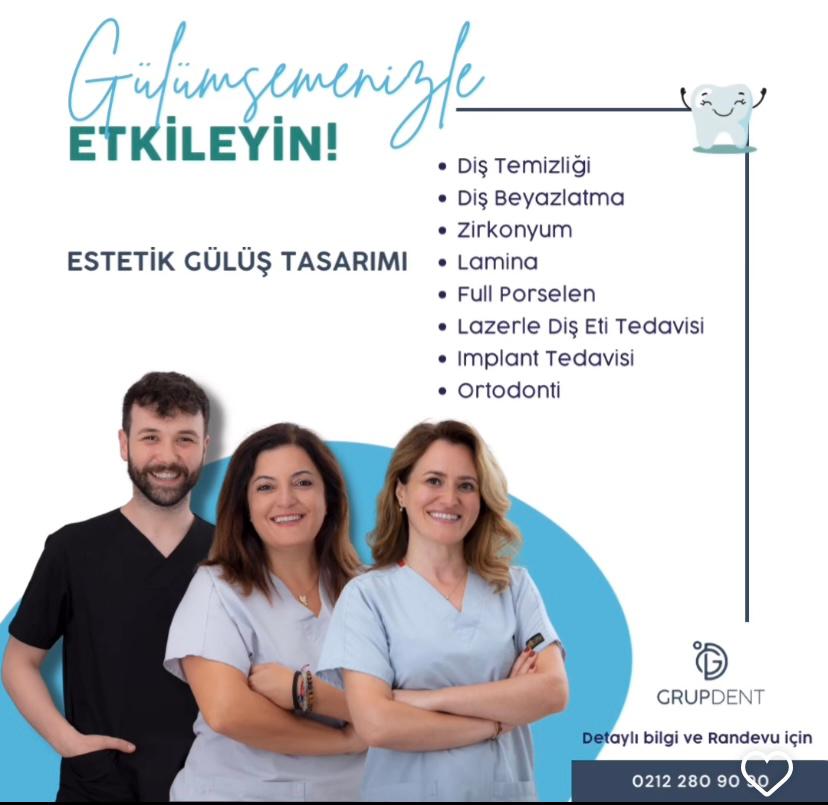
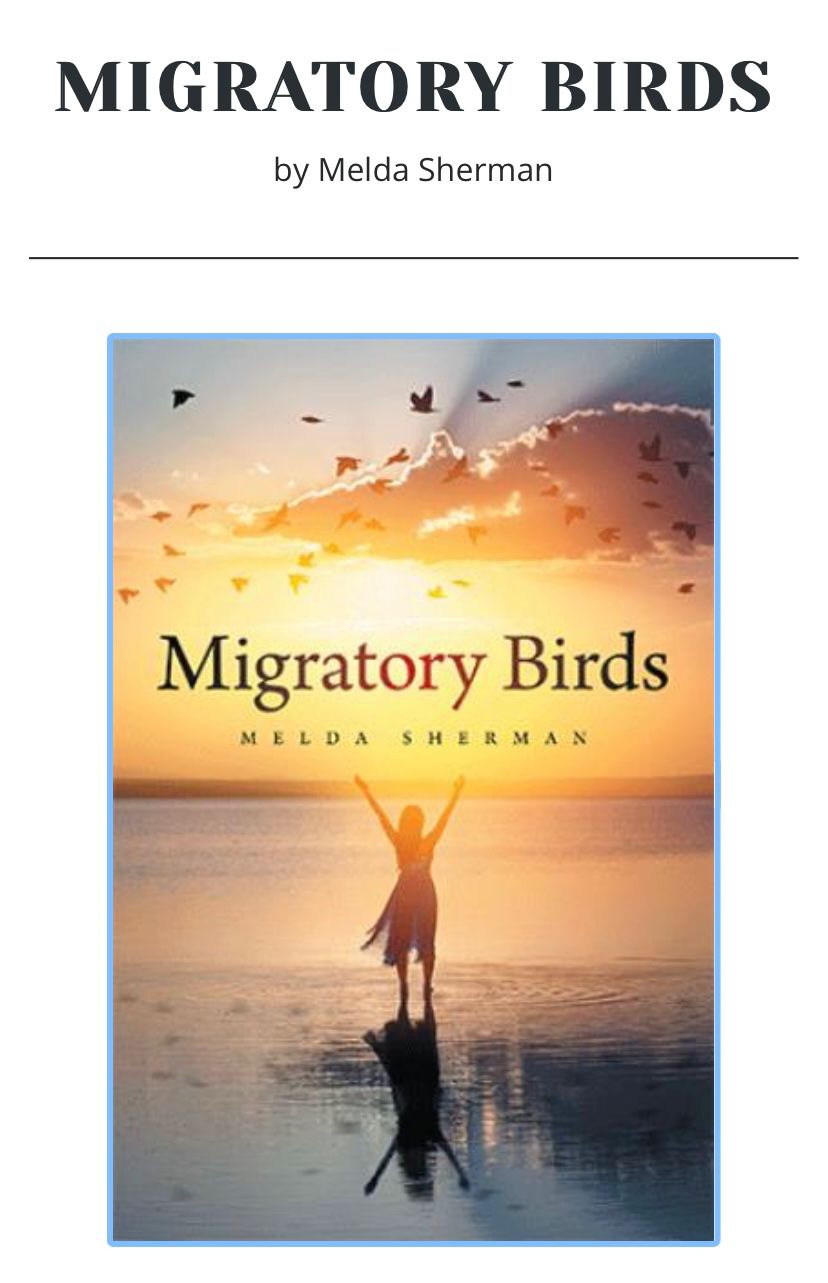
Harika bir yazı. Kaleminize sağlık.
Ah keşke orada olsak. Çok faydalı bir yazı olmuş.